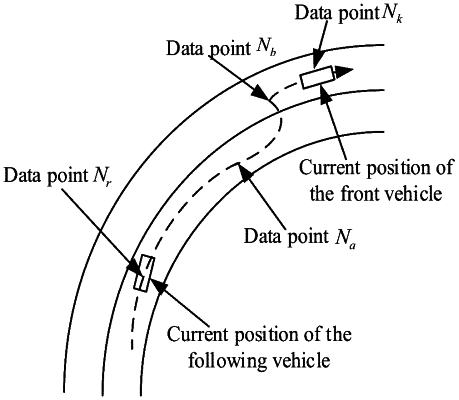| CPC G08G 1/167 (2013.01) [G08G 1/163 (2013.01); G08G 1/166 (2013.01)] | 10 Claims |

|
1. A method for determining a collision distance, applied to a first vehicle, and the method consists of the following steps:
receiving a series of data points sent by a second vehicle, wherein the data points are data points respectively collected at a plurality of historical moments in the process of the second vehicle driving on a historical path, the data points comprise path information and steering wheel angle of the second vehicle, the path information comprises position information of the second vehicle, the second vehicle is the front vehicle of the first vehicle;
determining whether the first vehicle is located within a preset area range corresponding to the second vehicle using a series of positions of the second vehicle and the current position of the first vehicle;
in the case of determining that the first vehicle is within the preset area range at the current moment, determining a lane change state of the second vehicle in the historical path according to the steering wheel angle, wherein the lane change state represents whether the second vehicle changes lanes;
determining a collision distance between the first vehicle and the second vehicle according to the lane change state, the current position of the first vehicle and a series of data points of the second vehicle;
wherein the step of determining a collision distance between the first vehicle and the second vehicle according to the lane change state, the current position of the first vehicle and a series of data points of the second vehicle comprises:
in the case of determining that the second vehicle has changed lanes in the historical path, determining a corresponding starting lane change data point when the second vehicle starts to change lane and a corresponding ending lane change data point when the second vehicle ends the lane change from the series of data points;
determining a data point interval where the nearest data point is located, wherein the nearest data point is a data point with the smallest distance from the current position of the first vehicle among the series of data points, the data point interval comprises a first interval, a second interval or a third interval, wherein the first interval comprises the data points from the starting data point to the starting lane change data point in the series of data points, the second interval comprises the data points from the starting lane change data point to the ending lane change data point in the series of data points, and the third interval comprises the data points from the ending lane change data point to the latest data point in the series of data points;
determining the collision distance according to the data point interval where the nearest data point is located, the lane change state, the current position of the first vehicle, and the series of data points;
the step of determining the collision distance according to the data point interval where the nearest data point is located, the lane change state, the current position of the first vehicle, and the series of data points comprises:
in the case of determining that the second vehicle has changed lanes in the historical path and the second vehicle is driving in the same lane as the first vehicle after changing lanes inwards:
when the data point interval where the nearest data point is located is the first interval, calculating the collision distance according to the following formula:
s=s1+s2+s3
wherein
s1=d(Nr,Nr+1)+d(Nr+1,Nr+2)+ . . . +d(Na−1,Na)−|θa−θr|w
s2=√d(Na,Nb)2−w2
s3=d(Nb,Nb+1)+d(Nb+1,Nb+2)+ . . . +d(Nk−1,Nk)
when the data point interval where the nearest data point is located is the second interval, calculating the collision distance according to the following formula:
s=s3+s4
wherein
s3=d(Nb,Nb+1)+d(Nb+1,Nb+2)+ . . . +d(Nk−1,Nk)
s4=d(Qr,Nb)
when the data point interval where the nearest data point is located is the third interval, calculating the collision distance according to the following formula:
s=s5
wherein
s5=d(Nr,Nr+1)+d(Nr+1,Nr+2)+ . . . +d(Nk−1,Nk)
wherein, s represents the collision distance, Nr represents the nearest data point, Na represents the starting lane change data point, Nb represents the ending lane change data point, Nk represents the latest data point, Qr represents the current position of the first vehicle, θa represents the driving azimuth angle of the second vehicle in the starting lane change data point, θr represents the driving azimuth angle of the second vehicle in the nearest data point, w represents the width of the lane where the first vehicle is located, d(Nr, Nr+1) represents the distance between the vehicle positions corresponding to the data points Nr and Nr+1, and d(Qr, Nb) represents the distance between the current position of the first vehicle and the vehicle position contained in the ending lane change data point.
|